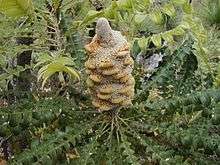Banksia grandis
Banksia grandis, commonly known as bull banksia[2] or giant banksia,[3] is a species of common and distinctive tree in the south-west of Western Australia. The Noongar peoples know the tree as beera, biara, boongura, gwangia, pira or peera.[4] It has a fire-resistant main stem with thick bark, pinnatisect leaves with triangular side-lobes, pale yellow flowers and elliptical follicles in a large cone.
| Bull banksia | |
|---|---|
 | |
| Scientific classification | |
| Kingdom: | Plantae |
| Clade: | Tracheophytes |
| Clade: | Angiosperms |
| Clade: | Eudicots |
| Order: | Proteales |
| Family: | Proteaceae |
| Genus: | Banksia |
| Subgenus: | Banksia subg. Banksia |
| Section: | Banksia sect. Banksia |
| Series: | Banksia ser. Grandes |
| Species: | B. grandis |
| Binomial name | |
| Banksia grandis | |
| Synonyms[1] | |
|
Sermuellera grandis (Willd.) Kuntze | |


Description
Banksia grandis is usually a tree that typically grows to a height of 5–10 m (16–33 ft) high, sometimes to 15 m (49 ft). It is also found in the form of a stunted, spreading shrub near the south coast, and whenever it occurs among granite rocks. Its trunks are short, stout and often crooked, with the rough grey bark characteristic of Banksia. The leaves are pinnatisect 100–450 mm (3.9–17.7 in) long and 30–110 mm (1.2–4.3 in) wide on a petiole 10–35 mm (0.39–1.38 in) long, with between eight an twelve large triangular lobes on each side of the leaf. The leaves are shiny dark green on the upper surface and softy-hairy underneath. The flowers are borne in a spike that is 100–400 mm (3.9–15.7 in) long and 70–90 mm (2.8–3.5 in) wide at flowering time with hairy involucral bracts up to 25 mm (0.98 in) long at the base of the head. The flowers are pale yellow with cream-coloured styles, the perianth 26–35 mm (1.0–1.4 in) long and the pistil 35–40 mm (1.4–1.6 in) long. Flowering occurs from October to January and the follicles are elliptical, 17–25 mm (0.67–0.98 in) long, 3–10 mm (0.12–0.39 in) high and 6–12 mm (0.24–0.47 in) wide on a massive cone. The old flower fall early and the follicles usually open as they mature. A seed from the south coast raised in Kings Park had retained its spreading habit as at 1981.[2][5][6][7]
Taxonomy and naming
Banksia grandis was first formally described in 1798 by Carl Ludwig Willdenow in the fourth edition of the book Species Plantarum.[8][9] The specific epithet (grandis) is a Latin word meaning "great", "large" or "tall".[10]
Banksia grandis is a member of Banksia series Grandes, a series containing only B. grandis and the closely related species B. solandri.[7]
Distribution
Bull banksia grows in woodland and heath on the coastal plain between Mount Lesueur and Cape Leeuwin, east to Cape Riche and inland to Woodanilling. It is common in the jarrah forest on the Darling Range.[5][6][7]
Ecology
Species of nectarivorous birds that have been observed feeding on B. grandis include Anthochaera carunculata (red wattlebird). Purpureicephalus spurius (red-capped parrot) has also been recorded feeding upon the seed, as have black cockatoos, though it is not clear which species of black cockatoo was observed, Calyptorhynchus baudinii (Baudin's black cockatoo) or C. latirostris (Carnaby's black cockatoo).[11]
Uses
Use in horticulture
Bull banksia is not often cultivated and is slow-growing, taking ten years or more to flower from seed. It is very sensitive to dieback and is difficult to grow in regions of summer humidity. It requires a well-drained sandy soil. Seeds do not require any treatment, and take 22 to 42 days to germinate.[7][12][13]
Use by Indigenous people
The flowers of Banksia grandis were known as mangyt, pulgarla or Bool gal la by the Indigenous peoples who live within its range. The flowers were steeped in water or sucked to obtain nectar.[14][15]
References
- "Banksia grandis". Australian Plant Census. Retrieved 1 May 2020.
- "Banksia grandis". FloraBase. Western Australian Government Department of Parks and Wildlife.
- Boland, Douglas J.; Brooker, M. Ian H.; Chippendale, George M.; Hall, Norman; Hyland, Bernard P.M.; Johnston, Robert D.; Kleinig, David A.; McDonald, Maurice W.; Turner, John D. (2006). Forest trees of Australia (5th ed.). Collingwood, Victoria: CSIRO Publishing. p. 636. ISBN 0643069690.
- "Noongar names for plants". kippleonline.net. Archived from the original on 20 November 2016. Retrieved 24 November 2016.
- George, Alex S. (1999). Flora of Australia (PDF). 17B. Canberra: Australian Biological Resources Study, Canberra. pp. 195–196. Retrieved 1 May 2020.
- George, Alex S. (1996). The Banksia Book (3rd ed.). Kenthurst, New South Wales: Kangaroo Press. pp. 76–77. ISBN 0-86417-818-2.
- George, Alex S. (1981). "The Genus Banksia L.f. (Proteaceae)". Nuytsia. 3 (3): 308–311. Retrieved 1 May 2020.
- "Banksia grandis". APNI. Retrieved 1 May 2020.
- Willdenow, Carl Ludwig (1798). Species Plantarum (4th ed., vol.1). p. 535. Retrieved 2 May 2020.
- Francis Aubie Sharr (2019). Western Australian Plant Names and their Meanings. Kardinya, Western Australia: Four Gables Press. p. 210. ISBN 9780958034180.
- Barker, R. D.; Vestjens, W. J. M. (1984). The Food of Australian Birds. Melbourne University Press. pp. 1:331, 365, 2:183, 458. ISBN 0-643-05006-X.
- Sweedman, Luke; Merritt, David (2006). Australian seeds: a guide to their collection, identification and biology. CSIRO Publishing. p. 203. ISBN 0-643-09298-6.
- "Banksia grandis". Australian Native Plants Society (Australia). Retrieved 2 May 2020.
- Plants used by south western aborigines - Western Australian Museum pamphlet, no author, no date
- The Perth Gazette Vocabulary of Aboriginal Language of Western Australia 31 August 1839 author:Lieutenant Grey, HM 83 regiment
- Powell, Robert (1990). Leaf and Branch: Trees and Tall Shrubs of Perth. Perth, Western Australia: Department of Conservation and Land Management.
- Taylor, Anne; Hopper, Stephen (1988). The Banksia Atlas (Australian Flora and Fauna Series Number 8). Canberra: Australian Government Publishing Service. ISBN 0-644-07124-9.
| Wikimedia Commons has media related to Banksia grandis. |
| Wikisource has original text related to this article: |